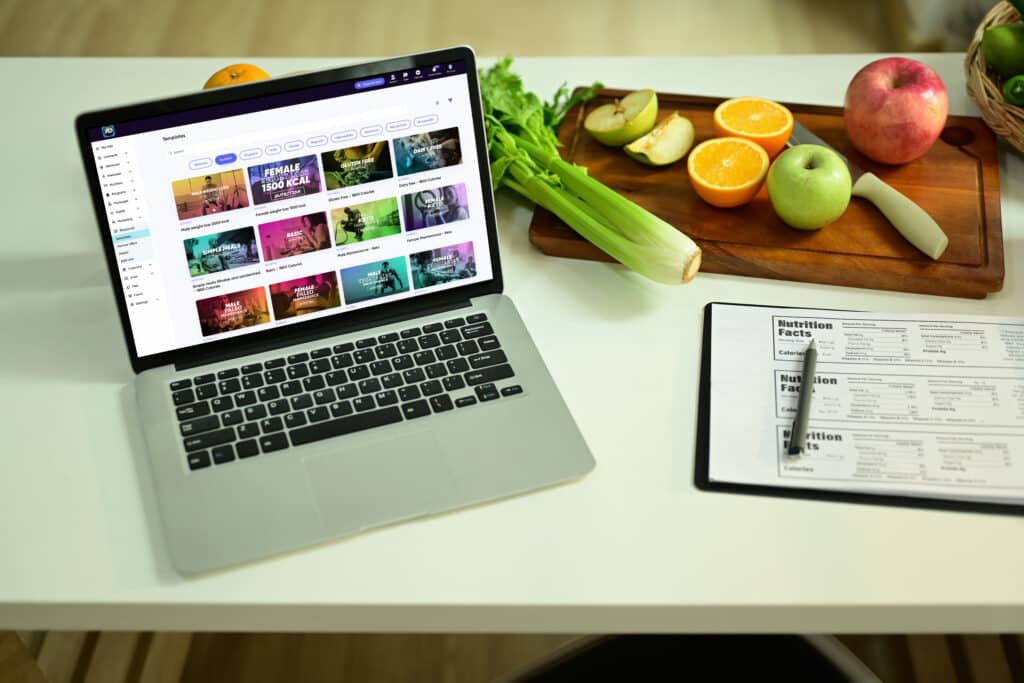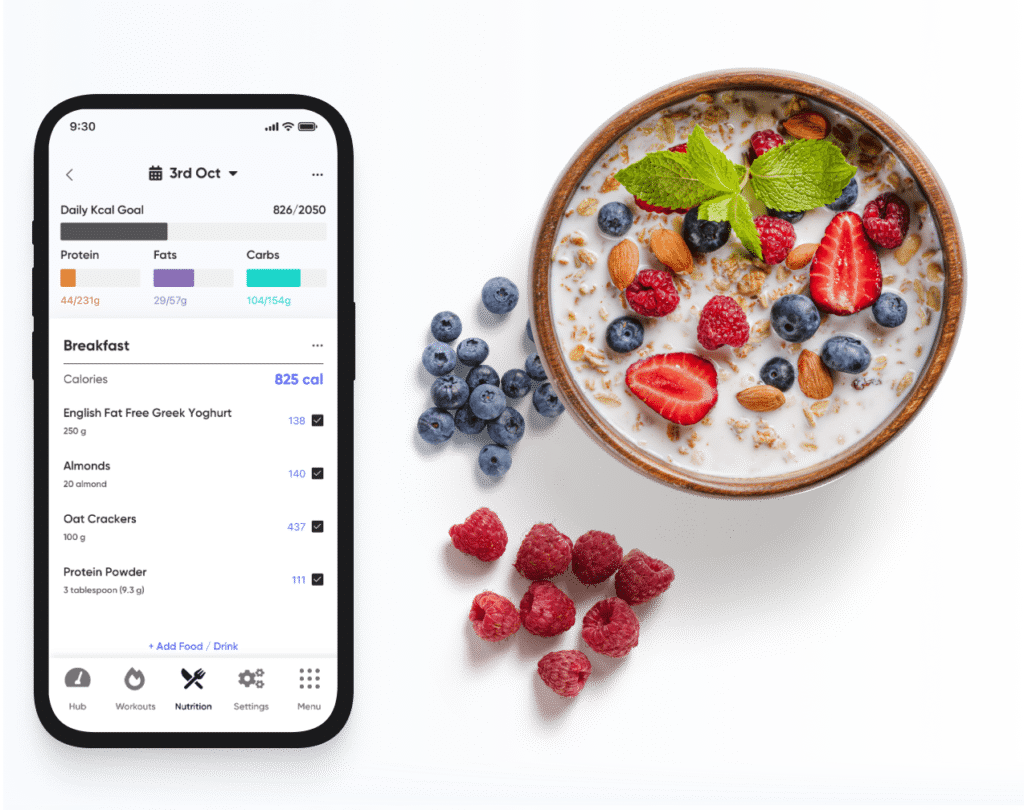In the journey towards effective and sustainable fat loss, understanding calorie deficits is essential. For personal trainers, guiding clients through calorie deficit plans can lead to healthier, more manageable weight loss results.
This article delves into what a calorie deficit is, the science behind it, and actionable strategies trainers can implement to help clients achieve their weight loss goals.
Plus, learn how My PT Hub’s all-in-one app can support clients with its dedicated nutrition coaching features, including tracking calorie intake, setting realistic targets, and staying consistent.
What is a calorie deficit and how does it link to fat loss?
A calorie deficit is created when a person consumes fewer calories than they burn. This leads to the body using stored energy, primarily from body fat, to meet its energy needs. This deficit drives fat loss because, in response to reduced calorie intake, the body taps into fat reserves for fuel.
What is TDEE?
Total Daily Energy Expenditure (TDEE) represents the calories a person burns daily. This includes both the energy used for basic bodily functions (Basal Metabolic Rate or BMR) and calories burned through physical activity.
A calorie deficit, widely recognized as an effective method for achieving fat loss, is founded on the principle of consuming fewer calories than one’s TDEE. This forces the body to burn fat reserves to get the energy it did not gain from calories.
Yet, this deficit must be manageable; otherwise, the body adapts by burning fewer calories over time, making continued weight loss more challenging.
It’s often said that a 3,500-calorie deficit leads to a loss of one pound (around 0.45kg) of fat. However – as many coaches and clients know from first-hand experience – weight loss doesn’t follow a strict formula, as the body’s response to calorie reduction varies significantly between individuals.
That’s why it’s crucial that both TDEE and BMR are worked out for each of your clients when working on calorie deficit plans.
Ultimately, one of the main reasons why there’s no “one-size-fits-all” solution for dieting is that TDEE and BMR are unique to each individual, so what works wonders for one client may differ significantly for another.
Think of it as the difference between your client following a generic diet from a PDF they found on the internet compared to following a tailor-made nutrition plan provided by a certified nutritionist.
Crafting a calorie deficit plan for your clients

Creating a calorie deficit plan that’s tailored to each client and their lifestyle is essential for success. Here are our top four tried-and-tested tips personal trainers can use when building out a calorie deficit plan for clients:
1. Calculate and track caloric needs
Start by calculating the client’s TDEE, factoring in age, weight, gender, and activity level.
Some nutrition coaching softwares like My PT Hub offer a built-in macro generator, allowing coaches to quickly and easily generate and assign macro and calorie targets to clients while taking into account their individual metrics and goals.
2. Set realistic and specific goals
Since weight loss isn’t strictly linear and varies by individual, emphasize setting gradual, realistic targets rather than focusing on rapid results.
For example, rather than aiming to lose a set number of pounds/kilograms/stone each week, clients can set goals related to reducing overall body fat percentage, improving energy levels, or enhancing physical performance.
3. Educate clients on nutrient-dense foods
A calorie deficit does not mean clients need to deprive themselves. Encourage clients to choose whole, nutrient-dense foods that provide essential vitamins and minerals while keeping them satisfied. Foods high in protein, fiber, and healthy fats are more satiating, making it easier to stick to a calorie deficit without excessive hunger.
For information about flexible dieting and how that might help clients in their dieting journey, read Becca Gillen’s guide here.
4. Incorporate exercise strategically
Physical activity is a powerful tool for increasing calorie expenditure. Help clients set workout plans that complement their diet goals, such as combining strength training with cardio.
Studies indicate that strength training not only helps burn calories but also preserves muscle mass, an important factor for metabolic health during fat loss.
Importance of a nutritional guide for fat loss
For many clients, understanding the nutritional side of fat loss can be challenging. What can they eat? What can’t they eat? How strict should they remain in their diet?
These are all questions you are there for. By providing a fat-loss nutrition guide, personal trainers can support their clients in deciding what foods to focus on and what foods they should limit.
A helpful framework includes:
- Lean proteins: boost satiety and muscle preservation (e.g., chicken, tofu, lentils).
- Complex carbohydrates: maintain energy levels with slow-releasing carbs (e.g., oats, brown rice).
- Healthy fats: support hormone balance and satiety (e.g., avocados, nuts).
- Fiber-rich vegetables: essential for digestive health and fullness (e.g., leafy greens, carrots).
*Pro tip: use specialized software with workout and habit tracking features to keep clients informed and accountable.
Common pitfalls with calorie deficits and how to avoid them

Calorie deficits can be challenging, especially for clients new to fitness and nutrition. Here’s how trainers can address common pitfalls:
1. Avoiding extreme calorie restriction
While a larger deficit might seem like a fast track to results, it often leads to burnout and nutrient deficiencies. Instead, encourage a moderate approach — clients who feel energized and satisfied after eating are more likely to adhere to their plan.
Remember: it’s better to start smaller. The body will eventually adapt and get used to the calorie deficit – if you go to the extreme too soon, it will be harder to keep it up.
2. Monitoring mental and physical health
Constantly restricting calories can impact mental health and physical performance. Remind clients that it’s okay to adjust their plan as needed and to include “refeed” days or meals occasionally to reset and refuel.
3. Staying flexible and adjusting goals
Weight loss isn’t linear, and clients may hit plateaus. In these moments, consider adjusting their plan, focusing on non-scale victories (like strength gains or improved energy), and maintaining open communication.
4. Ignoring nutritional quality
Focussing solely on calories can lead clients to poor food choices, like low-calorie (but nutrient-deficient) meals. Ensure that clients are educated on the benefits of whole and nutrient-dense foods like lean proteins, leafy greens and health fats.
5. Underestimating liquid calories
Yes, it’s unfair that margaritas contain calories, but it’s important that clients understand that high-calorie soft drinks and alcohol can derail calorie deficits faster than you can say “tequila!”. Encourage your clients to stay hydrated with plenty of water or low-calorie alternatives as part of their balanced nutrition plans.
6. Weight loss is a marathon, not a sprint
Life happens, and it’s not always possible to make 100% healthy choices all of the time. Remind clients that short-term over-indulgence for a friend’s wedding weekend doesn’t mean that they’ll immediately put weight back on or have “failed” themselves or their goals.
Getting your client back on track with their calorie-deficit plan is much more likely to generate positive weight loss results than them abandoning a diet completely because of the psychological shame of one “bad day”.
Calorie deficits with a focus on client health
Adopting a calorie deficit for fat loss is about more than the number on the scale; it’s about helping clients feel healthier, stronger, more confident, and more capable. Personal trainers who emphasize balanced nutrition, goal setting, and overall wellness can help clients build sustainable habits.
A calorie deficit, when approached mindfully and sustainably, is one of the most effective strategies for fat loss. Personal trainers and fitness coaches play an invaluable role in guiding clients through this process, helping them achieve results without sacrificing health.
Benefits of using software for calorie deficit coaching

Incorporating an all-in-one personal training app simplifies the process of tracking calories, planning workouts, and monitoring client progress.
Here’s how My PT Hub and its nutrition software for personal trainers can holistically support you in guiding clients through a successful calorie deficit journey:
Macro & calorie goal setting
Quickly generate tailor-made macro and calorie targets for your clients using My PT Hub’s built-in Macro calculator, which takes into account your clients’ individual body types, fitness goals, age, gender and more.
Alternatively, coaches can assign custom macro or calorie targets, depending on their preference.
Meal planning
With the ability to create and assign unlimited custom Nutrition plans using the world’s largest verified nutrition database, coaches can create highly personalized plans specific to every client’s unique dietary needs, preferences, allergies and fitness goals.
Download pre-made plans designed by certified nutritionists to speed up your program delivery or bulk-assign plans to multiple clients with a single click.
Nutrition logging
Clients can log meals, monitor calorie intake, and receive feedback from their trainers, ensuring they stay aligned with their goals via My PT Hub’s nutrition coaching features, including the ability to fast-scan food items with the built-in barcode scanner or integrate with third-party nutrition apps like MyFitnessPal.
Progress tracking
Trainers can also track client weight, measurements, and body composition to highlight real progress and generate custom reports to demonstrate their clients’ progress. This combined tracking of nutrition and physical changes can be a powerful motivator, helping clients stay focused and committed.
Workout programs
Create custom workouts and progressive multi-week programs that complement your clients’ calorie deficit, ensuring they burn calories efficiently and maintain muscle.
Habit coaching
Help clients develop sustainable habits, like meal prepping or hydrating adequately, through habit-tracking features.
Ready to guide clients through their fitness journey? Start your 30-day free trial to level-up your nutrition coaching practice today!